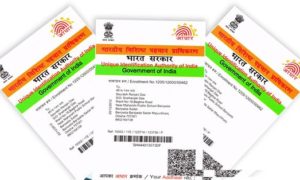Loopholes In Aadhaar System: Delhi Police have flagged some serious loopholes in the Unique Identification Authority of India (UIDAI)’s system as they discovered glaring gaps in the Aadhaar system while probing a bank fraud. The cops found out that the Aadhar system was not carrying out facial biometrics matching while generating an ID for any individual, reported TOI.
Read More:- Crude oil steadies as investors take stock of banking crisis
Delhi police, in a note for UIDAI, said, “We noticed that 12 bank accounts were opened digitally after verification from the Aadhaar database under the name of different persons even when the photographs on all the Aadhaar cards were of the same person. Thus, it became clear that it is possible for multiple Aadhaar cards to be generated by one person where the fingerprints in each are different but the photograph remains the same.”
The Delhi police during the probe revealed that the crooks are using the credentials of authorised agents, who had given them their silicon fingerprints and printouts of the IRIS scan and the laptops configured to them.
Read More:- Small cities’ incentive ban likely to have low impact
How Crooks Are Exploiting Gaps In Aadhaar System
As per the rule of UIDAI, the authorised agents are supposed to work only from authorised government offices and their GPS is captured by the system. However, in order to bypass this security, the fraudsters took the configured laptop once in 2-3 days to the designated government institution/office and synced the machine. By this, they are able to bypass this security check as the machine GPS shows the location of the government office for the next 2-3 days. The crooks are aware of this loophole.
Read More:- Air India Makes Another Voluntary Retirement Offer for Staff
Another issue with the Aadhaar system is that it is unable to differentiate between the silicon fingerprint and the live fingerprint of an individual. The fraudsters took advantage of this as they were able to log into the UIDAI system using the silicon fingerprints given to them by the authorised agents.
“The UIDAI system is also unable to detect the scan copy of IRIS Scan. IRIS scan is a biometric feature that is enabled to ascertain if a person is alive and sitting in front of the machine to log in to the system. But these persons were using the colour printout of the IRIS scan to log in and the same was not detected by the system,” the note adds.
According to police, the crooks were also able to edit/upload photographs of 12 entities into the database of UIDAI. “Prima facie, it is evident the UIDAI system is not matching the facial biometric features in their database and the accused persons were able to upload their photographs,” says the note.
Read More:-Salary Hiked For Govt Employees of This State by 20%. New Order to Be Effective From April 1
Another area of concern was that the Aadhaar system treated the 10 fingerprints of an individual as a single identity, not as 10 different unique identities, cops discovered after discussion with Aadhaar officials.
The fraudsters are aware of these loopholes and are creating several fake IDs by placing the fingers alternatively or mixing the fingerprints of one individual with those of another.





































